 The website is in construction. New files will be uploaded as soon as they are available.
The website is in construction. New files will be uploaded as soon as they are available.
GUIDO CASTELNUOVO
Venice 1865- Rome 1952
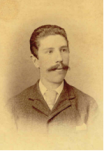
- Brief scientific biography
- Contributions to Education
- Essential bibliography
- Articles on the teaching of mathematics
Brief scientific biography
Guido Castelnuovo was born in Venice on 14 August 1865. Having been guided towards mathematics, during his secondary school studies, by A. Faifofer, in 1886 he graduated from the University of Padua, where he was taught by G. Veronese, who introduced him to the study of hyperspatial geometry. After a year (1886/1887) of specialisation in Rome, under the guidance of Luigi Cremona, Castelnuovo came to Turin.The Turin period (1887-1891), was extremely important for the orientation of his research, so much so that it was said that the new Italian geometry of algebraic curves was born of Castelnuovo's conversations with his friend and mentor Corrado Segre in the course of their long walks under the arcades of via Po. Thus the Italian school of algebraic geometry saw the light in Turin and, for a number of decades, it would put Italy amongst the forerunners in international scholarship.
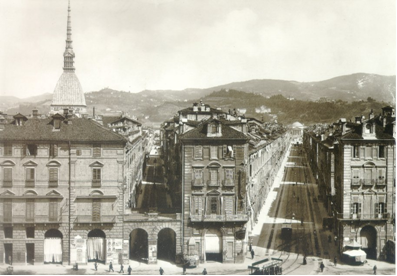
Turin Via Po, late 1800s
"We had created " in an abstract sense, of course " a large number of models of surfaces in our space or in higher spaces; and we had split these models, so to speak, between two display windows. One contained regular surfaces for which everything proceeded as it would in the best of all possible worlds; analogy allowed the most salient properties of plane curves to be transferred to these. When, however, we tried to check these properties on the surfaces in the other display, that is on the irregular ones, our troubles began, and exceptions of all kinds would crop up ... With the aforementioned procedure, which can be likened to the type used in experimental sciences, we managed to establish some distinctive characters between the two surface families ..." (G. CASTELNUOVO La geometria algebrica e la scuola italiana, Atti del Congresso Internazionale dei Matematici, Bologna, Zanichelli, 1928, I, 194).The working partnership of over twenty years between the two mathematicians whose copious correspondence offers a vivid and precious testimony (BOTTAZZINI, CONTE, GARIO 1996) was made possible by the combination of their different scientific qualities: while Enriques was endowed with an intellect of extraordinary power, it was, nonetheless, Castelnuovo who channeled its "torrential creativity" combining great breadth of vision and constructive criticism. As W. Hodge writes: "their partnership was one of the happiest examples of collaboration in mathematics" (HODGE 1953, 121).
Castelnuovo is one of principal creator both of geometry on algebraic curves, and of the theory of algebraic surfaces from the point of view of birational transformations. His scientific output consists of a hundred or so documents comprising notes, memoirs and treatises. In particular, the proof of the rationality of the plane involution (1893), the discovery of the necessary and sufficient condition for the rationality of a surface (1896), and the study of irregular surfaces (1905) are his most important contributions to algebraic geometry.
From 1906 on Castelnuovo's scientific activity, except for some sporadic contributions, was focused on other questions which identify his interests of a methodological, didactic, historical and physical order.
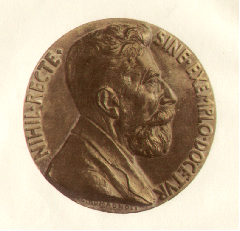
Gold medal awarded to Castelnuovo
by his students and followers
by his students and followers
During the years of racial persecution, from 1938 to 1943 Castelnuovo organised a secret University for the politically and racially persecuted in Rome and, in the nine months of the nazifascist occupation, he was hidden at the house of friends.
Castelnuovo was a member of numerous academies and scientific societies both in Italy and abroad: in particular, from 1901, he was a member of the Accademia dei Lincei, of which he was also president (1946-1952). He was a delegate on the International Commission on Mathematical Instruction (ICMI) from its foundation (1908) and was its vice-president from 1928 to 1932. In 1949, he was appointed senator for life.
He died in Rome on 27 April 1952.
Contributions to Education
Castelnuovo's commitment to education developed in a number of directions: in his activity in ICMI and in his role as president of Mathesis (1911-1914), the association of mathematics teachers founded in 1895-96; in his university courses, some of which were expressly geared towards teacher training; in various articles dedicated to the problems of the teaching of mathematics and in the drawing-up of secondary school syllabuses.As soon as Castelnuovo became an Italian ICMI delegate, he established important international contacts and promoted increased exchange of information on European reform movements, in particular that of Felix Klein, whose methodological principles he fully shared. During his presidency of the Mathesis Association,
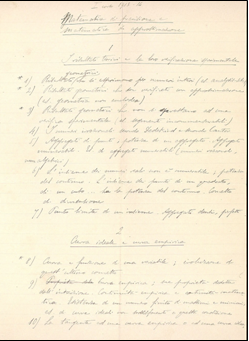
G. Castelnuovo, Corso di Geometria Superiore (1913-14)
"Nous demandons parfois "he writes" si le temps que nous consacrons aux questions d'enseignement n'aurait pas été mieux employé dans la recherche scientifique. Eh bien, nous répondons que s'est un devoir social qui nous force à traiter ces problèmes [...] Ne devons-nous pas faciliter à nos semblables l'acquisition du savoir, qui est à la fois une puissance et un bonnheur? " (CASTELNUOVO 1914, 191).His approach grew out of a lucid critique of the Italian school system - and in particular of the teaching of mathematics - which, in his opinion, was too abstract and theoretical: all reference to practical application was neglected and excessive specialisation and an unnecessary compartmentalisation of different areas led to a distorted cultural perspective:
"the general education which it [middle-school teaching] proposes to provide ought not to resemble a wild and mountainous land, whose peaks illuminated by the sun are separated from deep and unexplored abysses. It ought rather to be an already civilised domain, whose provinces are linked by bridges and roads" (CASTELNUOVO 1912-13, 16-17).
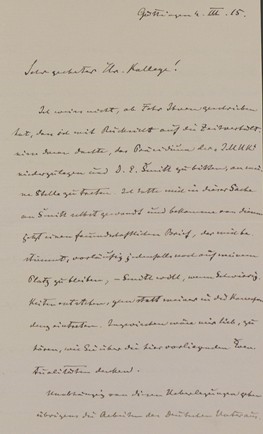
Klein to Castelnuovo, 4.3.1915
"Middle schools should not furnish their pupils with knowledge, so much as with the desire and the need for knowledge. They cannot seek to provide an encyclopaedic knowledge of everything, but can only offer a clear, although necessarily very limited, idea of the principle issues examined by the various branches of knowledge, and of some of the methods which have been employed in tackling them. They should not be afraid of sacrificing profundity for range of ideas [...] Of course, this kind of teaching will not be sufficient to provide middle school students with preparation specific to one or another of the faculties of the university. However, this is not the aim of middle schools. They serve simply to provide students with the aptitude to move on to more advanced studies" (CASTELNUOVO 1910, 24).In his article Il valore didattico della matematica e della fisica (1907) which almost constitutes a manifesto of his thought, the placing-together of mathematics and physics is no coincidence. Indeed, Castelnuovo upholds the importance of observation and experimental activities, the utility of continual comparing and contrasting of abstraction and reality and the importance of applications as a means of "shedding light on the value of science." He, moreover, believes that heuristic procedures should be favoured for two reasons:
"the first, and the most important reason, is that this type of reasoning is the best way to attain to truth, not just in experimental sciences, but also in mathematics itself [...] The other reason is in the fact that this is "the only kind of logical procedure that is applicable in everyday life and in all the knowledge involved with it." (CASTELNUOVO 1907, 336)His conception of mathematics teaching is reiterated in a number of slogans which often appear in his speeches and articles: "Rehabilitate the senses", "Break down the wall separating schools from the real world", or "Teaching should walk hand in hand with nature and with life."
In 1911 the minister Luigi Credaro instituted a liceo moderno which differed from the liceo classico from the second class onwards. The new curriculum replaced Greek with a modern language (German or English),
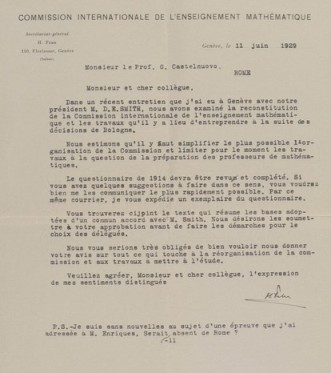
Fehr to Castelnuovo, 11.6.1929
"But if we truly wish", he writes, "that middle school children are inspired by modern mathematics and perceive something of the grandeur of its whole structure, we much speak to them of the concept of function and indicate, albeit in a brief and summary manner, the two operations which constitute the fundamental basis of infinitesimal calculus. In this way, if the pupil is to possess the scientific spirit, he will acquire a more correct and balanced idea of the exact sciences nowadays [...] If, instead, the pupil's mind is more disposed towards other subjects, he will at least find mathematics to be, instead of a logical drudge, a set of tools and results which can be easily applied to concrete problems" (CASTELNUOVO 1919, 5).
Always keen to establish and reinforce international contacts Castelnuovo presented the new syllabuses to the Conférence internationale de l'enseignement mathématique which was held in Paris in 1914.
His daughter Emma would take up her father's legacy.
Essential bibliography
G. CASTELNUOVO 1937, Memorie scelte, Bologna, Zanichelli.
G. CASTELNUOVO,Opere matematiche. Memorie e note, eds. E. Arbarello, U. Bottazzini, M. Cornalba, P. Gario, E. Vesentini, Accademia Nazionale dei Lincei, Roma, in press.
A. TERRACINI 1951-52, Guido Castelnuovo, Atti della Reale Accademia delle Scienze di Torino, 86, 366-377.
R. GARNIER 1952, Notice nécrologique sur M. Guido Castelnuovo, Comptes Rendus de l'Académie des Sciences Paris, 234, 2241-2244.
L. GODEAUX 1953, Guido Castelnuovo, Federigo Enriques et la géométrie, Revue Gén. Sci. Pures et Appliquées, 60, 8-14.
W. HODGE 1953, Guido Castelnuovo, Journal of the London Mathematical Society, 28, 1953, 120-125.
Onoranze alla memoria of Guido Castelnuovo, Rendiconti di matematica e delle sue applicazioni, 5, 13, 1-50 (with contributions by E. Bompiani, F. Severi, U. Papi, S. Visco, B. Segre, F. P. Cantelli and with a list of publications).
E. CARRUCCIO 1971, Castelnuovo Guido, Dictionary of Scientific Biography, 3, 1971, 117.
P. GARIO 1991, Singolarità e geometria sopra una superficie nella corrispondenza di C. Segre a G. Castelnuovo, Arch. Hist. Ex. Sci., 43, 145-188.
A. BRIGAGLIA, C. CILIBERTO 1995, Italian Algebraic Geometry between the Two World Wars, Kingston, Queen's University, 24-32.
U. BOTTAZZINI, A. CONTE, P. GARIO 1996, Riposte armonie Lettere di Federigo Enriques a Guido Castelnuovo, Torino, Boringhieri.
A. CONTE, L. GIACARDI 1999, G. Castelnuovo, in C.S. Roero (edited by) La Facoltà di Scienze Matematiche Fisiche Naturali di Torino, 1848-1998, Deputazione subalpina di storia patria, Torino, vol. II, 539-545.
P. GARIO (edited by) 2001-2003, Guido Castelnuovo. Quaderni delle lezioni, CD-Rom 1-6, Milano.
P. GARIO 2004, Guido Castelnuovo e il problema della formazione di docenti di matematica, Studies in the History of Modern Mathematics, V , Suppl. Rend. Circ. Mat. of Palermo, 74 , 103-121.
A. BRIGAGLIA 2006, Da Cremona a Castelnuovo. Continuità e discontinuità nella visione della scuola, in L. Giacardi (edited by), Da Casati a Gentile. Momenti di storia dell'insegnamento secondario della matematica in Italia, Pubblicazioni del Centro Studi Enriques, Agorà Edizioni, La Spezia, 159-179.
P. GARIO 2006, I corsi di Guido Castelnuovo per la formazione degli insegnanti, in L. Giacardi (edited by), Da Casati a Gentile... , 239-268.
L. GIACARDI 2006, From Euclid as Textbook to the Giovanni Gentile Reform (1867-1923). Problems, Methods and Debates in Mathematics Teaching in Italy, Paedagogica Historica. International Journal of the History of Education, 42, 2006, 589-615, at pages 604-607.
Articles on the teaching of mathematics
G. CASTELNUOVO 1907, il valore didattico della matematica e della fisica, Rivista di Scienza, 1, 329-337.
G. CASTELNUOVO 1909, Sui lavori della Commissione Internazionale pel Congresso of Cambridge. Relation del prof. G. Castelnuovo della R. Università di Roma, Atti II Congresso della Mathesis, Padova, 20-23 Settembre 1909, Allegato F, 1-4.
G. CASTELNUOVO 1910, La scuola media e le attitudini che essa deve svegliare nei giovani, Federazione Nazionale Insegnanti Medi, 33-47.
G. CASTELNUOVO 1911, Commissione internazionale dell'insegnamento matematico - Congresso di Milano, Bollettino della Mathesis, 172-184.
G. CASTELNUOVO 1911, La rigueur dans l'enseignement mathématique dans les écoles moyennes, Milano 1911, L'Enseignement mathématique, 13, 1911, 461-464.
G. CASTELNUOVO 1912, I programmi di matematica proposti per il liceo moderno, Bollettino della Mathesis, IV, 120- 130
G. CASTELNUOVO 1912a, La commissione internazionale dell'insegnamento matematico al Congresso di Cambridge, Bollettino della Mathesis, IV, 131-139.
G. CASTELNUOVO 1912-13, Scuola nei suoi rapporti colla vita e colla Scienza moderna, Atti III Congresso della Mathesis, Genova, 21-24 Ottobre 1912, 15-21.
G. CASTELNUOVO 1913, I programmi di matematica del liceo moderno, Bollettino della Mathesis, V, 86-94 (see. also Bollettino Ufficiale del Ministero dell'Istruzione Pubblica, 1913 in http://www.subalpinamathesis.unito.it/storiains/it/liceomod.pdf.
G. CASTELNUOVO 1913a, Risposta ad un'osservazione del Prof. Catania, Bollettino della Mathesis, V, 119-120.
G. CASTELNUOVO 1913b, Osservazioni all'articolo precedente, Bollettino della Mathesis, V, 143-145.
G. CASTELNUOVO 1914, Discours de M.G. Castelnuovo, Publications du Comité central II s., III, 1914, Compte Rendu de la Conférence internationale de l'enseignement mathématique, Paris,1-4 avril 1914, L'Enseignement mathématique, 16, 188-191 .
G. CASTELNUOVO 1914a, La riunione di Parigi della Commissione internazionale dell'insegnamento matematico, Bollettino della Mathesis, VI, 85-88.
G. CASTELNUOVO 1918, Il calcolo delle probabilità e le scienze di osservazione, Rivista di Scienza 23, 176-184.
G. CASTELNUOVO 1918a, Questioni di metodo nel calcolo delle probabilità, Rivista di Scienza, 23, 241-248.
G. CASTELNUOVO 1919, la riforma dell'insegnamento matematico secondario nei riguardi dell'Italia, Bollettino della Mathesis, XI, 1-5.
G. CASTELNUOVO 1920, Sull'insegnamento medio delle matematiche in Italia dal 1867 ad oggi, Bollettino della Mathesis, XII, p 17-21.
G. CASTELNUOVO (rapporteur) 1923, Sopra i problemi dell'insegnamento superiore e medio a proposito delle attuali riforme, Rome, Tip. della R. Accademia Nazionale dei Lincei, 1-12.
Author
Livia Giacardi
Department of Mathematics
University of Turin - ITALY
livia.giacardi@unito.it
